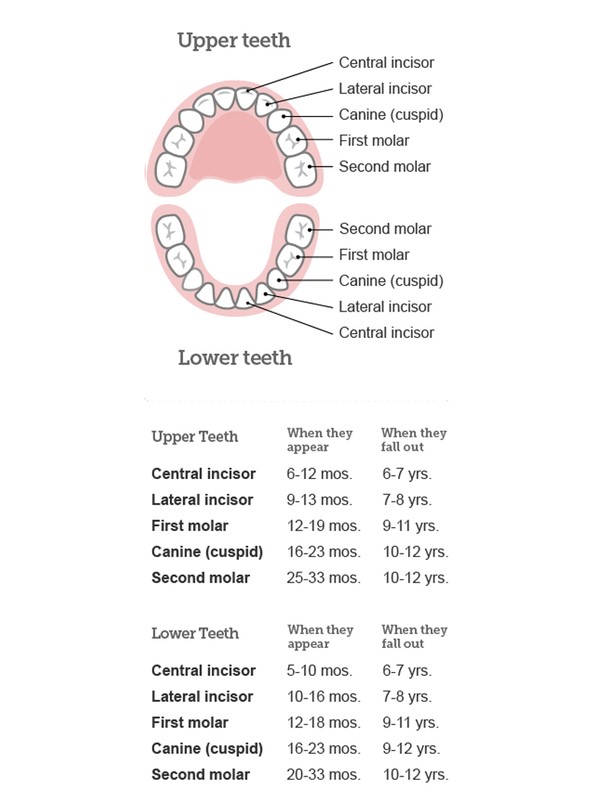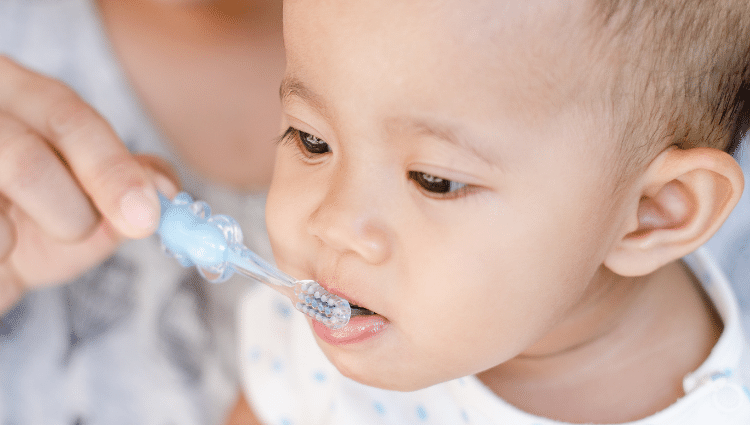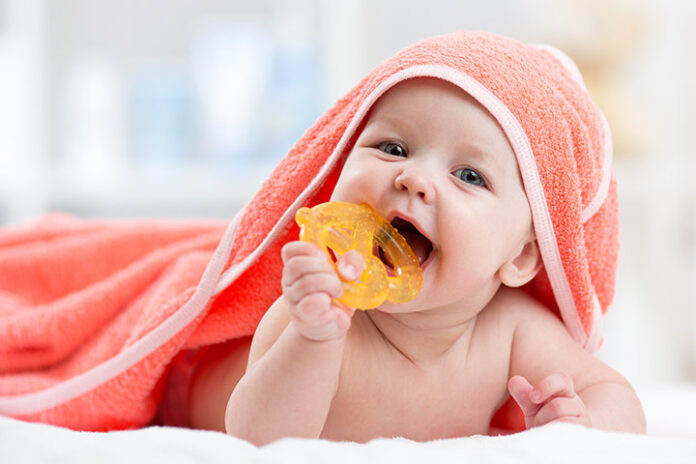Your child’s survival and growth are based on his or her baby teeth. They assist him in chewing, speaking, and laughing. When a baby tooth is lost too young, the permanent teeth can drift into the empty room, making it impossible for other adult teeth to erupt. Teeth may become uneven or crowded as a result of this.
That’s why learning proper oral hygiene from an early age will help preserve a child’s teeth for a lifetime by baby teeth chart. Find out what order your baby’s teeth are expected to come in (and when they’ll fall out!) with our useful baby teeth chart. Baby teeth from while the baby is still in the womb. A maximum collection of 20 baby teeth is concealed in the gums of newborns. Teeth occur in most babies between the ages of 6 and 10.
Teeth may start as early as three months in some infants. They don’t come for another year or two in some situations. Teeth come in at various intervals with different children. Only a small proportion of infants are born with only one or two teeth. Baby teeth can appear in any order, but the central bottom teeth are usually the first to appear. By the time your infant reaches three years old, all 20 baby teeth should have arrived. Between the ages of 6 and 20, the 32 adult teeth replace the baby teeth.
Baby Teeth Chart

When Does Baby Teething Start?
Though teething can occur as early as 3 months, the first tooth will most likely start breaking through your baby’s gum line when he or she is between the ages of 4 and 7. The two lower front teeth, also known as central incisors, are usually the first teeth to emerge.
They’re usually accompanied by the four front upper teeth four to eight weeks after (central and lateral incisors). The lower lateral incisors (the two teeth flanking the bottom front teeth) would emerge about a month later.
The first molars (back teeth used for grinding food) are the next to crack through, followed by the eyeteeth (the pointy teeth in the upper jaw). By their third birthday, most infants have all 20 of their main teeth. (Speak to the dentist if your child’s teeth are coming in even later than this.)
Rarely, infants are born with one or two teeth, or a tooth develops within the first few weeks of childhood. This is generally not a cause for alarm unless the teeth are obstructing feeding or are loose enough to pose a choking threat.
Baby Teething

When a baby tooth hits the gum’s top, the gum opens up to expose the tooth. When new teeth begin to appear through the gums, babies may rub their gums together. Normally, this isn’t a concern. Many parents claim the ‘teething’ babies also:
- Cry a lot or look irritable.
- Don’t eat as much as usual.
- Chew on things like dolls, dummies, and bibs.
- Get more messy nappies.
- Pull the ear to the same side as the erupting tooth.
Teething can cause these effects, but they may also be a natural part of growth or the result of mild diseases or illnesses. If your baby isn’t feeling good, it’s better to take him or her to the hospital, particularly if he or she has a fever or diarrhea, or whether you’re nervous about some other signs.
Why Is It So Necessary to Take Care of Your Baby’s Teeth?
Though baby teeth are only in the mouth for a short time, they are incredibly necessary.
- Make room for their permanent equivalents by extracting baby teeth.
- Return the mask to its original condition.
- Aid with the production of simple expression.
- Aid with maintaining proper diet (missing or decayed teeth make it difficult to chew, causing children to reject foods)
- Aid with giving permanent teeth a good start (decay and infection in baby teeth can cause damage to the permanent teeth developing beneath them)
In which order will your child’s baby teeth come in and fall out?
Tooth buds were growing under your baby’s gums long before they were born. This map demonstrates when pearly whites usually emerge, as well as when baby teeth tend to fall out to make room for permanent ones.
Please bear in mind that this is just a checklist. Your baby’s first tooth should develop at the age of three months or around their first birthday. And certain newborns are born with teeth! It’s also good if the child’s teeth come in or fall out in a different order than this.
Lower incisors (central incisors)
Between the ages of five and ten months, the lower middle teeth normally appear first. Since tooth growth is genetic, if you grew your teeth early, your baby is likely to do so as well.
Incisors in the upper central zone
The upper middle teeth appear between the ages of six and twelve months. Teeth usually come in pairs. The incisors on the upper sides of the mouth are called lateral incisors. The upper teeth would be visible to the right and left of the middle between the ages of nine and thirteen months. This would result in a series of four teeth around the top of your baby’s mouth.
Lateral incisors on the lower jaw
Around the ages of 10 and 16, the lower teeth to the right and left of the middle make a mark. Your baby will now look at you with a toothy grin.
Initial molars in the upper jaw
Around the ages of 12 and 19, your child’s first molars, the larger teeth in the back of the mouth, will appear.
Initial molars of the lower jaw
For about the same time as the upper molars, the lower first molars will appear at the bottom.
Canine upper
Between the ages of 16 and 23, the upper canines bridge the distance between the incisors and the first molars.
Canine lower jaw
The lower canines emerge between the ages of 16 and 23 months. Since baby teeth are whiter than permanent teeth, your child’s grin is likely to be the best it will ever be.
Second molar in the lower jaw
Between the ages of 20 and 33 months, the back molars generally come out on the bottom first.
Second molar in the upper jaw
Your baby’s last teeth, the top rear molars, appear between the ages of 25 and 33 months. Many infants have a complete set of 20 baby teeth by the age of three and will flash you a dazzling smile.
What is the Safest Way to Take Care of Baby’s Teeth?

Long-term oral wellbeing depends on how much you care for and brush your baby’s teeth. And if the first set of teeth would fall out, tooth decay accelerates the process, leaving holes until the permanent teeth are able to appear. In an effort to fill in the holes, the remaining primary teeth can crowd together, allowing the permanent teeth to come in crooked and out of alignment.

